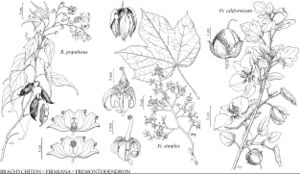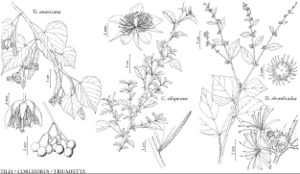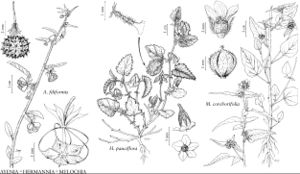FNA>Volume Importer |
GeoffLevin (talk | contribs) m (Deleted extraneous text from synonyms) |
||
| (5 intermediate revisions by 3 users not shown) | |||
| Line 4: | Line 4: | ||
|publications= | |publications= | ||
|basionyms= | |basionyms= | ||
| − | |synonyms= | + | |synonyms= |
| − | |||
| − | |||
| − | |||
|hierarchy=Malvaceae | |hierarchy=Malvaceae | ||
|hierarchy_nav=<div class="higher-taxa"><div class="higher-taxon"><small>family</small>[[Malvaceae]]</div></div> | |hierarchy_nav=<div class="higher-taxa"><div class="higher-taxon"><small>family</small>[[Malvaceae]]</div></div> | ||
| Line 51: | Line 48: | ||
<h3 class="treatment-key-header" id="key-0">Key to Subfamilies of Malvaceae</h3> | <h3 class="treatment-key-header" id="key-0">Key to Subfamilies of Malvaceae</h3> | ||
{| class="wikitable fna-keytable" | {| class="wikitable fna-keytable" | ||
| − | |-id=key-0-1 | + | |- id="key-0-1" |
|1 | |1 | ||
|Gynoecium apocarpous; petals absent; epicalyx absent; androgynophore present; flowers functionally unisexual | |Gynoecium apocarpous; petals absent; epicalyx absent; androgynophore present; flowers functionally unisexual | ||
| − | |[[Sterculioideae|Sterculioideae]] | + | |[[Malvaceae subfam. Sterculioideae|Sterculioideae]] |
| − | |-id=key-0-1 | + | |- id="key-0-1" |
|1 | |1 | ||
|Gynoecium syncarpous; petals present or absent; epicalyx present or absent; androgynophore present or absent; flowers usually bisexual | |Gynoecium syncarpous; petals present or absent; epicalyx present or absent; androgynophore present or absent; flowers usually bisexual | ||
|[[#key-0-2| > 2]] | |[[#key-0-2| > 2]] | ||
| − | |-id=key-0-2 | + | |- id="key-0-2" |
|2 | |2 | ||
|Petals absent | |Petals absent | ||
| − | |[[Bombacoideae|Bombacoideae]] | + | |[[Malvaceae subfam. Bombacoideae|Bombacoideae]] |
| − | |-id=key-0-2 | + | |- id="key-0-2" |
|2 | |2 | ||
|Petals usually present | |Petals usually present | ||
|[[#key-0-3| > 3]] | |[[#key-0-3| > 3]] | ||
| − | |-id=key-0-3 | + | |- id="key-0-3" |
|3 | |3 | ||
|Epicalyx usually absent | |Epicalyx usually absent | ||
|[[#key-0-4| > 4]] | |[[#key-0-4| > 4]] | ||
| − | |-id=key-0-3 | + | |- id="key-0-3" |
|3 | |3 | ||
|Epicalyx usually present, rarely absent | |Epicalyx usually present, rarely absent | ||
|[[#key-0-5| > 5]] | |[[#key-0-5| > 5]] | ||
| − | |-id=key-0-4 | + | |- id="key-0-4" |
|4 | |4 | ||
|Androgynophore absent; nectaries on sepals | |Androgynophore absent; nectaries on sepals | ||
| − | |[[Tilioideae|Tilioideae]] | + | |[[Malvaceae subfam. Tilioideae|Tilioideae]] |
| − | |-id=key-0-4 | + | |- id="key-0-4" |
|4 | |4 | ||
|Androgynophore present or absent; nectaries on petals or androgynophore | |Androgynophore present or absent; nectaries on petals or androgynophore | ||
| − | |[[Grewioideae|Grewioideae]] | + | |[[Malvaceae subfam. Grewioideae|Grewioideae]] |
| − | |-id=key-0-5 | + | |- id="key-0-5" |
|5 | |5 | ||
|Staminodes usually present; anthers 2- or 3-thecate | |Staminodes usually present; anthers 2- or 3-thecate | ||
| − | |[[Byttnerioideae|Byttnerioideae]] | + | |[[Malvaceae subfam. Byttnerioideae|Byttnerioideae]] |
| − | |-id=key-0-5 | + | |- id="key-0-5" |
|5 | |5 | ||
|Staminodes absent or relatively small; anthers 1-thecate | |Staminodes absent or relatively small; anthers 1-thecate | ||
| − | |[[Malvoideae|Malvoideae]] | + | |[[Malvaceae subfam. Malvoideae|Malvoideae]] |
|} | |} | ||
</div></div><!-- | </div></div><!-- | ||
| Line 100: | Line 97: | ||
|rank=family | |rank=family | ||
|parent rank= | |parent rank= | ||
| − | |synonyms= | + | |synonyms= |
|basionyms= | |basionyms= | ||
|family=Malvaceae | |family=Malvaceae | ||
|illustrator=Linny Heagy | |illustrator=Linny Heagy | ||
| + | |illustration copyright=Flora of North America Association | ||
|distribution=Nearly worldwide. | |distribution=Nearly worldwide. | ||
|reference=bayer1999a;bayer2003a;brizicky1966a;judd1997a;whetstone1983a | |reference=bayer1999a;bayer2003a;brizicky1966a;judd1997a;whetstone1983a | ||
| Line 109: | Line 107: | ||
|publication year= | |publication year= | ||
|special status= | |special status= | ||
| − | |source xml=https:// | + | |source xml=https://bitbucket.org/aafc-mbb/fna-data-curation/src/2e0870ddd59836b60bcf96646a41e87ea5a5943a/coarse_grained_fna_xml/V6/V6_337.xml |
}}<!-- | }}<!-- | ||
| − | -->[[Category:Treatment]] | + | --> |
| + | [[Category:Treatment]] | ||
Latest revision as of 16:34, 9 December 2022
Herbs, subshrubs, shrubs, or trees, usually stellate-hairy. Leaves alternate, usually spiral, sometimes distichous (Malvoideae), usually petiolate, sometimes subsessile or sessile (Malvoideae), stipulate (usually well developed), simple (compound in Abelmoschus); blade unlobed or palmately lobed, palmately veined. Inflorescences axillary, terminal, or leaf-opposed. Flowers bisexual or unisexual, usually actinomorphic; involucel (epicalyx) sometimes deciduous (Malvoideae, Sterculioideae), (4–)5(–8), distinct or connate; petals 4 or 5 (absent in Bombacoideae and Sterculioideae, rarely absent in Grewioideae); nectaries glandular hairs on adaxial base of sepals, petals, or androgynophores, sometimes absent; androgynophore present or absent; stamens [4–]5–100[–1500], usually in antipetalous groups; usually same number as sepals, distinct or connate, sessile or on androgynophore; ovules (1–)2–many per ovary. Fruits usually capsules, sometimes follicles, schizocarps, berries, or nuts. Seeds: cotyledons usually folded, endosperm absent or sparse to copious.
Contents
Distribution
Nearly worldwide.
Discussion
Genera ca. 240, species ca. 4350 (52 genera, 250 species in the flora).
Malvaceae comprise taxa traditionally separated among four families: Malvaceae, Bombacaceae Kunth, Sterculiaceae Ventenat, and Tiliaceae Jussieu. Morphological characters distinguishing these previously recognized families are notoriously ambiguous and/or absent. Multiple tribes and genera (for example, Fremontodendron) have been transferred between families as taxonomic boundaries changed throughout history. Molecular phylogenies indicate that only one of the four previously recognized families (Malvaceae in the narrow sense) forms a monophyletic group (C. Bayer et al. 1999; W. S. Alverson et al. 1999) and the monophyly of an expanded familial circumscription, including all four previously accepted families, is well documented (W. S. Judd and S. R. Manchester 1997; Alverson et al. 1998; Bayer et al.). Based on morphological, molecular, and biogeographic data, Malvaceae now include nine subfamilies (Bayer et al.; Alverson et al. 1999), six of which are represented in the flora area; Malvoideae and Bombacoideae form a monophyletic group that is part of a larger clade that includes some
traditional components of Tiliaceae and Sterculiaceae (now Tilioideae and Sterculioideae). A second clade contains Grewioideae and Byttneriodeae. Not included in the flora are members of subfamilies Brownlowioideae Burret, Dombeyoideae Beilschmied, and Helicteroideae Meisner.
Malvaceae range widely in inflorescence structure; all members share a basic repeating bicolor unit (a terminal flower and three bracts or an epicalyx; C. Bayer 1999). Floral nectaries in the family are composed of dense multicellular, glandular hairs on sepals, petals, or androgynophore (S. Vogel 2000). These nectaries provide nectar to a broad range of cells in wood; M. M. Chattaway 1933) are restricted to Malvaceae but are not present in every taxon.
Representatives of Malvaceae are present on every continent except Antarctica; diversity increases in warmer regions. A majority of the genera in Malvoideae and Bombacoideae are native to the New World (P. A. Fryxell 1997); members of Byttnerioideae, Grewioideae, and Sterculioideae are more evenly distributed throughout the Tropics. Tilioideae are restricted to the Northern Hemisphere (C. Bayer and K. Kubitzki 2003).
Malvaceae have an extensive pollen fossil record and a majority of the subfamilies are represented in the Paleocene or Eocene. Tilia (Tilioideae) fossil pollen and leaves are present in western North American temperate forests (where it is now absent) from the mid Eocene (S. R. Manchester 1994; H. W. Meyer and Manchester 1997). North American fossil pollen deposits of Bombacoideae are plentiful in the Cretaceous (W. Krutzsch 1989; B. E. Pfeil et al. 2002 and references therein).
The hairy seed coat of cotton [Gossypium (Malvoideae)] is the most economically valuable product in the family and the historical and evolutionary importance of its domestication is well documented. The seeds of cacao [Theobroma cacao (Sterculioideae)] are the basis of chocolate. Okra [Abelmoschus esculentus (Malvoideae)] is a major vegetable crop in the southeastern United States. Tilia (Tilioideae) trees are planted throughout temperate regions to beautify streets and parks. The marshmallow, Althaea officinalis (Malvoideae), is a perennial herb found in northeastern North America and Europe; the mucilage from its roots was used to make the original marshmallow.
Key to Subfamilies of Malvaceae
Selected References
Lower Taxa
Illustrations
Key
Key to Subfamilies of Malvaceae
| 1 | Gynoecium apocarpous; petals absent; epicalyx absent; androgynophore present; flowers functionally unisexual | Sterculioideae |
| 1 | Gynoecium syncarpous; petals present or absent; epicalyx present or absent; androgynophore present or absent; flowers usually bisexual | > 2 |
| 2 | Petals absent | Bombacoideae |
| 2 | Petals usually present | > 3 |
| 3 | Epicalyx usually absent | > 4 |
| 3 | Epicalyx usually present, rarely absent | > 5 |
| 4 | Androgynophore absent; nectaries on sepals | Tilioideae |
| 4 | Androgynophore present or absent; nectaries on petals or androgynophore | Grewioideae |
| 5 | Staminodes usually present; anthers 2- or 3-thecate | Byttnerioideae |
| 5 | Staminodes absent or relatively small; anthers 1-thecate | Malvoideae |


